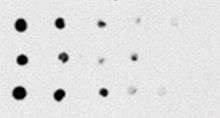Dot blot
A dot blot (or slot blot) is a technique in molecular biology used to detect proteins. It represents a simplification of the western blot method, with the exception that the proteins to be detected are not first separated by electrophoresis. Instead, the sample is applied directly on a membrane in a single spot, and the blotting procedure is performed.

The technique offers significant savings in time, as chromatography or gel electrophoresis, and the complex blotting procedures for the gel are not required. However, it offers no information on the size of the target protein.[1]
Uses
Performing a dot blot is similar in idea to performing a western blot, with the advantage of faster speed and lower cost.
Dot blots are also performed to screen the binding capabilities of an antibody.[2]
Methods
A general dot blot protocol involves spotting 1–2 microliters of a samples onto a nitrocellulose or PVDF membrane and letting it air dry. Samples can be in the form of tissue culture supernatants, blood serum, cell extracts, or other preparations.[3]
The membrane is incubated in blocking buffer to prevent non-specific binding. It is then incubated with a primary antibody followed by a detection antibody or a primary antibody conjugated to a detection molecule (commonly HRP or alkaline phosphatase). After antibody binding, the membrane is incubated with a chemiluminescent substrate and imaged.
Apparatus
Dot blot is conventionally performed on a piece of nitrocellulose membrane or PVDF membrane. After the protein samples are spotted onto the membrane, the membrane is placed in a plastic container and sequentially incubated in blocking buffer, antibody solutions, or rinsing buffer on shaker. Finally, for chemiluminescence imaging, the piece of membrane need to be wrapped in a transparent plastic film filled with enzyme substrate.
Vacuum-assisted dot blot apparatus has been used to facilitate the rinsing and incubating process by using vacuum to extract the solution from underneath the membrane, which is assembled in between several layers of plates to ensure good seal between sample wells, hold waste solution, and deliver suction force. For chemiluminescence signal detection, apparatus need to be disassembled and the membrane need to be taken out and wrapped in a transparent plastic film.
References
- "Test Blots, Slot Blots & Dot Blots - Immunodetection | Bio-Rad". Bio-Rad.
- Rupprecht, Kevin R.; Nair, Rad K.; Harwick, Larissa C.; Grote, Jonathan; Beligere, Gangamani S.; Rege, Sushil D.; Chen, Yon-Yih; Lin, Zhen; Fishpaugh, Jeffrey R. (15 December 2010). "Development of a dot-blot assay for screening monoclonal antibodies to low-molecular-mass drugs". Analytical Biochemistry: 160–164. doi:10.1016/j.ab.2010.08.003. PMID 20696124.
- "Dot Blot Protocol" (PDF).